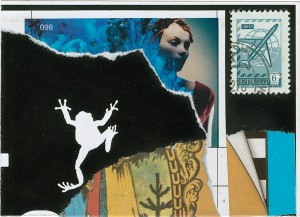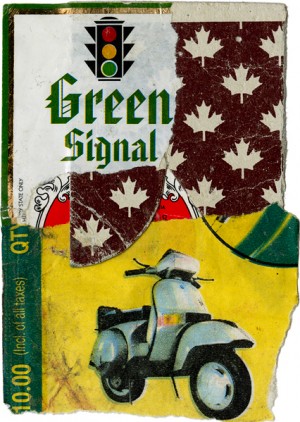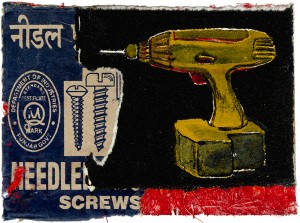A consummate traveler, Carl David Ruttan makes collages with graphic ephemera he finds along the way: Chinese cigarette cartons, Indian candy wrappers, torn bits of music posters from the street. Working in a rented room in Berlin, a youth hostel in Switzerland, on the beach in India, or his apartment in Montreal, Ruttan spreads out the fragments and brings the bits and pieces together in composition. When done, he slides the small 3.75” x 2.75” collages into a plastic sleeve. At Atelier Circulaire in Montreal, Ruttan scans them at extremely high resolution, and produces one unique print to accompany the original collage as the final, archivally stable work of art. The final photographic quality digital print creates a convincing tactile optic which the eye perceives as an original collage.
Carl David Ruttan was born in 1976 in Oshawa, Ontario. He studied fine art at the University of Ottawa, completing his Bachelors of Fine Art in 2000. He has traveled extensively in Asia, North America, Europe and on numerous islands of the Caribbean and South Pacific. Carl settled in Montreal in 2001 after his first trip to Asia. Ruttan is an active member of both the printmaking workshop Atelier Circulaire and Montreal artist-run centre articule.
Like many contemporary artists, Ruttan’s art making practice includes many mediums. He makes small dry-point intaglio and relief prints that offer a unique aesthetic and a simple, accessible style. He takes macro photographs of found objects, urban scenes, and textures of various sorts—paint, plywood, brick—and blows them up. He has maked some sculpture and he paints with acrylic on canvas and wood. Yet, it is in his collage work that the dominant themes of his art practice come together. Multi-layered, texture-rich colour compositions are composed from the colours and images that printed media lay before the artist as he navigates the sea of symbols around him. They are both the vehicle for self-expression, and limiting agent, determining the palette and tiny details of paper quality that will define the final work.






